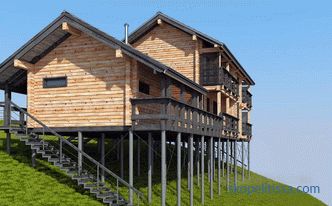The use of paving stones as a pavement with the beginning of the use of asphalt and concrete has practically ceased, however, its use in arranging pavements, garden paths and the garden land generally thrives, as the aesthetic qualities of the tiles give the site a rich, stylish look. In this article, you will learn how pavers tracks are made, possible laying options, features, as well as the main types of materials used.
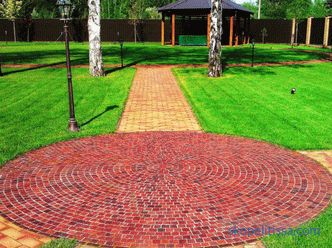
Materials used in the production of paving stones and their advantages
There are four types of paving stones: concrete, granite, clinker and rubber.
Concrete paving stones are presented in the form of equal concrete bars, this type has good resistance to abrasion and is not high cost. Often it is used in paving the sidewalks of cities.
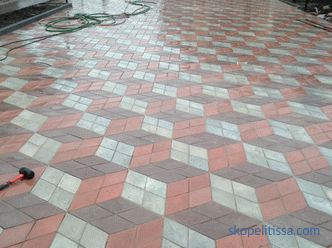
Stone tiles, in particular from granite, marble , shale, basalt, is the most durable, the service life may be more than 50 years.
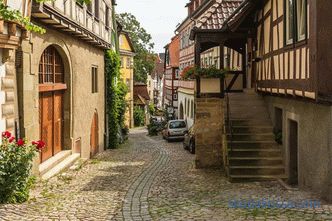
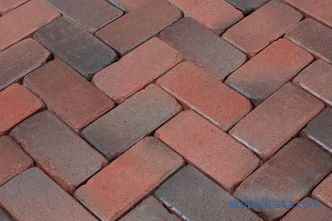
The rubber tile is made by pressing rubber crumb together with plasticizers, dyes. The term of use of such tiles can reach 30 years, and due to the use of secondary material resources, its cost is lower than cement-sand.
Regardless of the type, the main advantages of choosing this kind of track formation are long service life, the ability to choose different shapes of tiles, a certain pattern, the color of paving stones, the absence of changes in their properties when exposed to strong frosts, or the same excess of sunlight, high humidity.
The general stages of creating a paving stone walkway on your own
The process of creating garden paths from paving stones can be divided into several stages:
-
Preparatory stage.
-
Preparation of the ground selected under track .
-
Installation of curb stone.
-
Laying paving .
Preparatory stage
Regardless of the readiness and novelty of your site, whether it will be a refinement of the current landscape or the development of a perfect new plan, it is worth displaying the planned track on the plan, site map indicating the actual size to the nearest environment, fence, facade, take into account the area covered by wide shrubs and trees.
Using the lined plan, the best solution would be to designate the planned section with a few pegs and a rope, forming a perimeter for future paving.
In parallel with determining the place, it is worth thinking about the color and material of the paving stone. Paths from paving stones in landscape design play an important role in shaping the style of your home.
Land preparation
Before starting work on removing the top layer of the earth, it is important to keep in mind that to prevent excessive contamination of the track, it should be 1-2 cm higher than the ground. To prevent water accumulation it is necessary to make a transverse and longitudinal slope, 4-6 and 2 cm, respectively, per 1m of the coating.
In addition to the paving stone itself, you will need sand, a curb and material of the drainage layer.
It is recommended to use the building thread to determine the slope and respect the depth over the entire area of the trench. A dug trench should be well tamped, after which the drainage layer is laid. The essence of the drainage layer is to prevent sand blurring between the tiles, which consists of large fractions of broken brick, rubble, ceramics and other similar material with a size of from 20 to 40 mm. The drainage layer should also be even and well tamped.
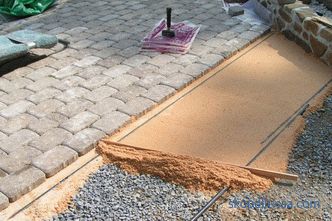
On our site you can see the most popular 3184 house designs from best construction companies with an impeccable reputation in the market. A wide choice, reasonable price from 51050 rubles, flexible conditions and quality guarantee allow you to choose the right option for any budget and realize all the wishes of the client. Directly to communicate with representatives, you can visit the exhibition of houses "Low-rise Country".
Installation of curbstone
Curbstone is placed on the drainage layer with the condition of a drainage layer below it at least 5 cm. The height of the curbstone does not matter and represents, in general, only an aesthetic function. The installation of the stone should be carried out strictly with a lined plan.
After installing the curbstone, it is recommended to add a small layer of drainage layer of 2-4 cm, then start to cover the formed bowl with sand, tamping and pouring sand. When watering sand, small grains of sand fill cavities in the adjacent drainage layer, due to which it is possible to avoid subsidence of paving stones for a long time.
The curbstone is held together by a sand-cement mortar, so after tamping the last fraction of sand, it is necessary to give the curb to grab at least one day.
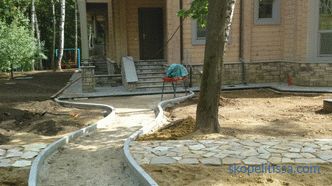
Laying paving stones
Laying paving stones should be carried out starting from the corner. In order the seams between the pavement were the same, the tiles are separated by wooden strips with a thickness of 0.6 - 1 cm. If there are subsided tiles, they must be removed, and more sand must be poured under the installation site and then installed again.
After the tamping is completed and the level is checked, it is necessary to cover the joints with sand with wooden strips, then pour water over the tiles, in order for the sand to shrink. After one day there is an additional sanding with watering. The pavement path is ready.
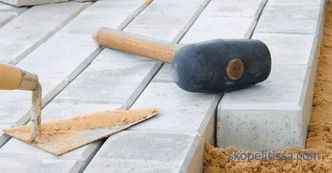
Useful tips for shaping paving stones
Usage geotextiles and geogrids
The enveloping of the drainage and sandy layers in geotextiles will prevent the possible destruction of the layer under the action of excess water for decades. This material will significantly extend the durability of the foundation of the track, protect from single subsidence of tile.
You can use a geogrid to improve the overall stability of the embankment - special reinforcing layer that can serve as a separating substrate between different types of embankment.
The most popular manufacturers and construction companies are collected at the exhibition and presented on our website. Here you can find contacts, select and order any service, including repair of the foundation, installation of metal structures (sheds, greenhouses, etc.), roof repair, construction of fences and fences. Directly to communicate with representatives, you can visit the exhibition of houses "Low-rise Country".
Use of a vibrating plate and stone cutting tools
When deciding to create curved, curved paths, you have to use a grinder with a disc on a stone, or a stone-cutting machine. For the implementation of complex projects, it would be reasonable to hire a specialized organization that would have all the special equipment, experts would help with a good choice of location and consult on the quality of your soil.
Features of using natural stone
Concrete paving tiles in landscape design is a less refined material than natural stone. Granite, basalt can most often be found in the form of cubes with sides of 5, 7, 10 cm. Paths from granite paving stones require careful filling of gaps and good drying. Often they do not have a curb, which deprives the coating of strong compression. Paths from natural stone also require a good drainage layer, which performs the role of a curb hidden 2-5 cm from the top of the soil.
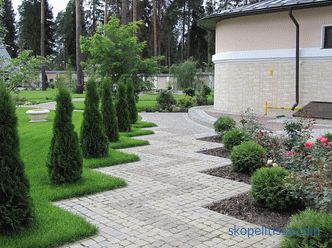
It may be interesting! In the article on the following link read about the technology of laying paving stones and the nuances of the installation process.
Features of laying clinker paving
Clinker paving, in addition to the sand and gravel base can be placed on the concrete, fixing with special mounting glue. This method is much harder and more expensive, but the tile with the correct work will always be in the prescribed form. This paving advised to lay in dry weather, or under an awning.
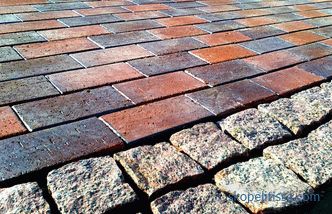
The video shows how to make a garden path out of paving stones, order Execution of works: excavation, laying of geotextiles, insulation of polystyrene foam, sand filling, installation of curb stone, laying of paving stones, sealing of seams:
This can be interesting! In the article on the following link read about paving paving: price, features and varieties.
Conclusion
Pavement paths in a country house, their design, significantly affects the overall exposure of your site. Laying paving stones in the home is a very real task. The most important thing is to adhere to the main stages of the formation of the trail with the achievement of rammed and even layers. The variety in color and type of material gives everyone the opportunity to choose the individual and original landscape of their site.
